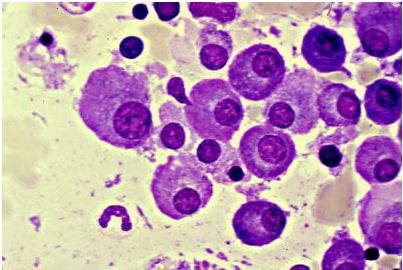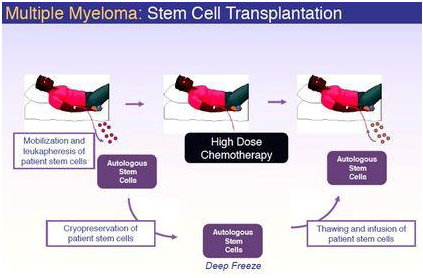
What is myeloma ?
Multiple myeloma is a cancer from a type of blood cell known as a plasma cell. Plasma cells help you fight infections by making antibodies that recognize and attack germs. Multiple myeloma causes cancer cells to accumulate in the bone marrow, where they crowd out healthy blood cells.The myeloma cells continue trying to produce antibodies, as healthy plasma cells do, but the myeloma cells produce abnormal antibodies that the body can't use. Instead, the abnormal antibodies (monoclonal proteins, or M proteins) build up in the body and cause problems, such as damage to the kidneys.

Symptoms
Signs and symptoms of multiple myeloma can vary and, early in the disease, there may be none. When signs and symptoms do occur, they can include:
- Bone pain, especially in your spine or chest
- Nausea
- Constipation
- Loss of appetite
- Mental fogginess or confusion
- Fatigue Frequent infections Weight loss Weakness or numbness in your legs Excessive thirst.
Diagnosis
- In some cases, your doctor may detect multiple myeloma accidentally when you undergo a blood test for some other condition. In other cases, your doctor may suspect multiple myeloma based on your signs and symptoms.
- Tests and procedures used to diagnose multiple myeloma include:
- Too much calcium in your blood (your doctor may call it "hypercalcemia")
- Anemia (too few red blood cells)
- Kidney problems
- High protein levels in your blood combined with a low albumin level (your doctor may say you have a "globulin gap")

If your doctor thinks you have multiple myeloma, he'll test your blood, urine, and bone marrow. Some tests he may order include:
- Electrophoresis, which measures immunoglobulins (something your body makes when it's fighting something). Laboratory analysis of your blood may reveal the M proteins produced by myeloma cells. Another abnormal protein produced by myeloma cells — called beta-2-microglobulin — may be detected in your blood and give us clues about the aggressiveness of your myeloma.
- Blood urea nitrogen, also known as BUN, and creatinine -- to check how well your kidneys are workingA CBC, which stands for complete blood count, which measures and counts the cells in your blood.
- Urine tests: Analysis of your urine may show M proteins, which are referred to as Bence Jones proteins when they're detected in urine.
- X Rays of the bones may show 'holes' in them.
- Examination of your bone marrow: The sample is collected with a long needle inserted into a bone (bone marrow aspiration and biopsy). In the lab, the sample is examined for myeloma cells. Specialized tests, such as fluorescence in situ hybridization (FISH) can analyze myeloma cells to understand their chromosome abnormalities. Tests are also done to measure the rate at which the myeloma cells are dividing.
- Imaging tests: Imaging tests may be recommended to detect bone problems associated with multiple myeloma. Tests may include MRI, CT or positron emission tomography (PET) in addition to X Rays.
Treatment
Treating multiple myeloma usually helps people who already have:
- Anemia
- High blood calcium
- Kidney problems
- Lytic bone lesions
We usually use chemotherapy to treat the disease. Treatment may include some of these drugs:
- Adriamycin, doxil (Doxorubicin)
- Bortezomib
- Bendamustine
- Carfilzomib

- Cyclophosphamide (Cytoxan)
- Lenalidomide (Revlimid)
- Melphalan (Alkeran)
- Pomalidomide
- Thalidomide
- Vincristine
- Corticosteroids
Most of the treatment is given on an outpatient basis and you don't need to get hosptitalized. Bisphosphonates are drugs used to treat bone damage. Commonly used drugs are Zolendronate and Ibandronate which you'll get through a vein. Be especially good about your dental hygiene while taking these medications. There is a rare risk of deterioration of the jaw. That risk can increase if you get dental work. The most effective treatment for multiple myeloma is stem cell transplantation (SCT). In SCT, some of your stem cells are removed by a machine, frozen, and stored. Next, you may have high-dose chemotherapy. This will destroy almost all the cells in the bone marrow -- both healthy cells and the plasma cells that cause the disease. The stem cells are then injected into your veins. They travel to the bone marrow, where they multiply and make new, healthy blood cells. Stem cell transplantation doesn't cure multiple myeloma, but it often helps you live longer. It's important for you to know that SCT can cause serious complications, including making you more prone to infections.


The outcome
With modern treatment, the future is becoming brighter for patients with myeloma. Most patients can expect years of symptom free and pain free life.
